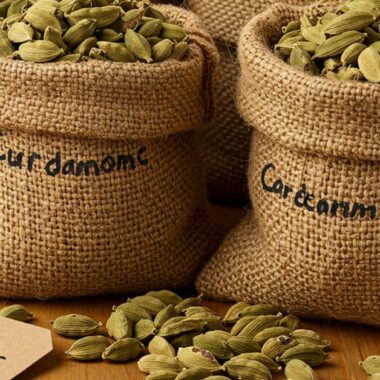Agroforestry is an innovative and sustainable agricultural practice that combines forestry and agriculture. It involves growing trees alongside crops, creating a more diverse ecosystem and benefiting both the environment and the farmer. In cardamom cultivation, agroforestry plays a critical role in promoting sustainability, improving soil health, and enhancing crop yield. 🌱
In this blog, we will explore the key benefits of integrating agroforestry into cardamom farming, and how it can help farmers achieve a more sustainable and productive future. 🌍
What is Agroforestry? 🌳
Agroforestry is the practice of planting trees or shrubs alongside agricultural crops to create a diverse farming system. This approach combines the benefits of both agriculture and forestry, using trees to complement crops, providing environmental, social, and economic advantages. In cardamom farming, agroforestry typically involves planting shade trees such as silver oak, teak, or cardamom-friendly species, which provide shade and protect the plants from harsh weather conditions. 🌞
Key Benefits of Agroforestry in Cardamom Cultivation 🌱
1. Improved Soil Fertility 🌍
One of the most significant benefits of agroforestry is the improvement of soil fertility. Trees in agroforestry systems help in several ways:
- Tree roots fix nitrogen in the soil, enriching it with essential nutrients.
- Leaf litter from trees decomposes and adds organic matter to the soil, improving its texture and nutrient content.
- The trees help reduce soil erosion by stabilizing the soil with their roots, preventing nutrient loss during heavy rains. 🌧️
This results in healthier soil, which is crucial for growing high-quality cardamom. The rich, fertile soil supports better growth, higher yields, and reduced dependence on synthetic fertilizers. 🌿
2. Protection from Pests and Diseases 🐞
Agroforestry promotes biodiversity by encouraging the growth of a variety of plants. A diverse environment helps reduce the risk of pest and disease outbreaks in cardamom plantations. Here’s how:
- Trees can host beneficial insects, which help control pests naturally.
- Mixed crops provide natural barriers against pest spread and reduce the impact of diseases.
- The variety of plants in agroforestry systems also reduces the need for chemical pesticides, making the entire farming system more sustainable. 🌱
3. Enhanced Microclimate 🌥️
Shade trees in agroforestry systems are essential for regulating temperature and humidity, creating a favorable microclimate for cardamom plants. Cardamom thrives in shaded conditions, and too much direct sunlight can damage the delicate plants. Here’s how trees help:
- They provide shade, protecting cardamom plants from intense heat and sunburn.
- The canopy of trees helps maintain high humidity, which is crucial for the growth of cardamom, especially in tropical environments.
- The trees reduce wind speed, protecting plants from strong winds that could damage or dry out the cardamom crops. 🌿
This microclimate support leads to healthier and more resilient cardamom plants, ultimately increasing yields. 🌾
4. Carbon Sequestration 🌍
Trees absorb carbon dioxide (CO2) from the atmosphere, storing it in their biomass and helping mitigate the effects of climate change. In agroforestry systems, trees act as carbon sinks, which makes them an important tool in climate change mitigation. Here’s how this benefits cardamom farmers:
- Agroforestry helps reduce carbon emissions, supporting sustainable farming practices.
- By increasing the overall carbon sequestration on the farm, cardamom farmers can help combat global warming while improving farm productivity in the long run. 🌿
Agroforestry thus plays a role not only in sustainable farming but also in global environmental health. 🌍
5. Diversification of Income Sources 💰
Agroforestry systems offer opportunities for farmers to diversify their income streams, improving financial resilience. By planting high-value trees such as teak or eucalyptus, farmers can generate additional revenue alongside cardamom production. Farmers can also harvest timber, fruits, or nuts from trees, or sell wood products.
This diversification reduces the financial risk that comes with relying solely on cardamom crops, especially during years of poor yield or unfavorable market conditions. 💡
6. Improved Water Management 💧
Water management is crucial for cardamom cultivation, as the plant requires a consistent and adequate water supply. Agroforestry plays a role in conserving and managing water resources:
- The tree canopy helps reduce evaporation from the soil, maintaining moisture levels for cardamom plants.
- Trees can act as windbreaks, preventing water loss due to wind evaporation.
- Tree roots also help with water retention, ensuring that water is more evenly distributed throughout the farm. 🌧️
This ensures a steady water supply, which is critical for the growth of cardamom crops in areas with varying rainfall patterns. 💧
How to Implement Agroforestry in Cardamom Farming 🌳
Farmers interested in integrating agroforestry into their cardamom cultivation can take the following steps:
- Choose the Right Tree Species: Select trees that are compatible with cardamom crops and the local climate, such as silver oak, teak, and banana trees.
- Plan Tree Spacing: Space trees properly to ensure adequate sunlight for cardamom plants while still providing the necessary shade.
- Integrate Multiple Crops: Consider planting other crops alongside cardamom to enhance biodiversity and reduce pest pressure.
- Use Organic Practices: Avoid synthetic fertilizers and pesticides, and instead, use organic methods to ensure a sustainable farming environment.
- Monitor Soil Health: Regularly check soil quality and adjust practices based on soil health, ensuring that both cardamom and trees thrive.
By following these steps, farmers can successfully implement agroforestry and boost the sustainability of their cardamom farm. 🌱
🌿 Conclusion 🌍
Agroforestry plays a vital role in the sustainability of cardamom farming. It offers a variety of benefits, from improving soil fertility and protecting crops from pests to enhancing farm biodiversity and providing additional income sources. By incorporating agroforestry into cardamom cultivation, farmers can create a more resilient, productive, and sustainable farming system.
Are you interested in exploring agroforestry practices for your cardamom farm? Start small, experiment with different tree species, and see the benefits unfold! 🌿🌍
Looking for top-quality cardamom for your next recipe? Visit Greengold Guide’s cardamom products for premium, sustainably sourced cardamom. 🌱












